Contents
- 1 Assignment One
- 2 Answer the following descriptive category questions in about 500 words each. Eachquestion carries 20 marks.
- 3 1. Describe the types of counseling and the approaches to counseling.
- 4 2. Discuss the various stages of counseling with the help of a case example.
- 5 Assignment Two
- 6 Answer the following middle category questions in about 250 words each. Each question carries 10 marks.
- 7 3. Explain the ethical guidelines in counseling.
- 8 4. Explain the criteria for selecting an appropriate test.
- 9 5. Discuss the role of counselor in existential therapy.
- 10 Assignment Three
- 11 Answer the following short category questions in about 100 words each. Each question carries 6 marks.
- 12 6. Case history
- 13 7. Five stages of grief
- 14 8. Benefits of art therapy
- 15 9. Cerebral palsy
- 16 10. Imagery re-scripting
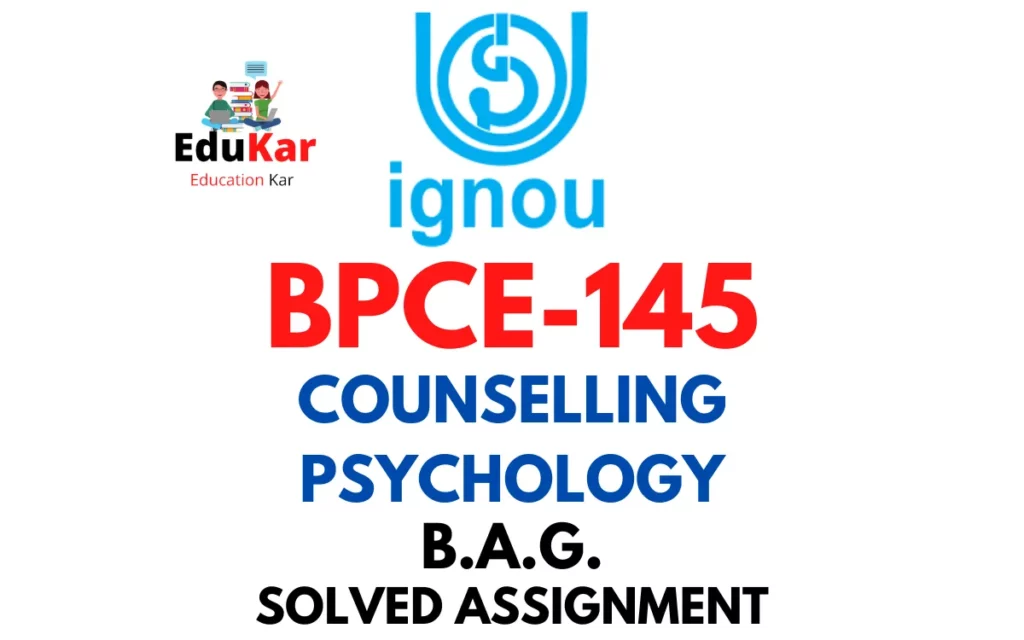
| Title | BPCE-145: IGNOU BAG Solved Assignment 2022-2023 |
| University | IGNOU |
| Degree | Bachelor Degree Programme |
| Course Code | BPCE-145 |
| Course Name | COUNSELLING PSYCHOLOGY |
| Programme Name | Bachelor of Arts (General) |
| Programme Code | BAG |
| Total Marks | 100 |
| Year | 2022-2023 |
| Language | English |
| Assignment Code | ASST/TMA/2022-23 |
| Last Date for Submission of Assignment: | For June Examination: 31st April For December Examination: 30th September |
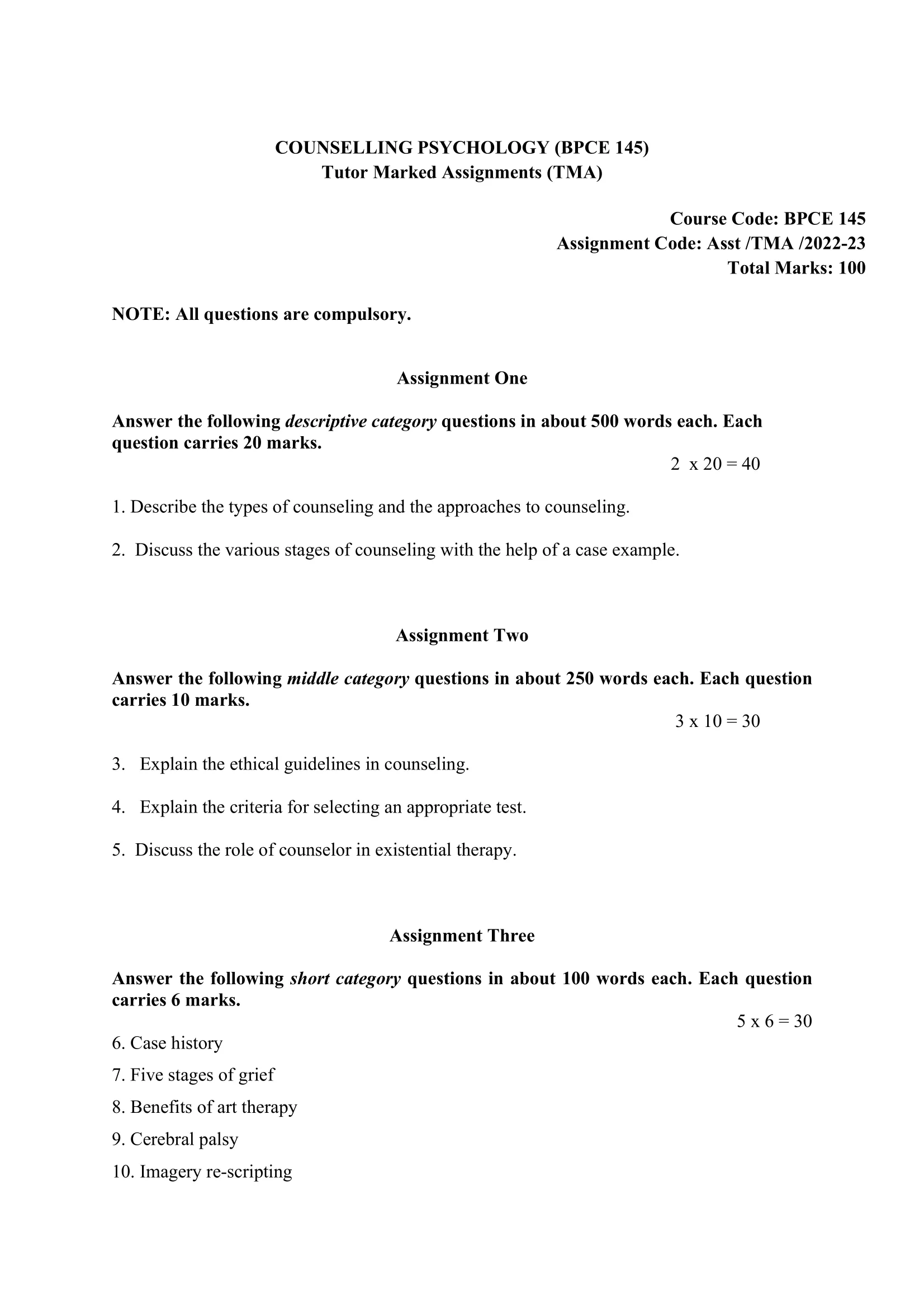
Assignment One
Answer the following descriptive category questions in about 500 words each. Each
question carries 20 marks.
1. Describe the types of counseling and the approaches to counseling.
Ans: Types of Counseling:
Counseling is a process of assisting individuals to cope with their emotional and psychological issues, interpersonal problems, and mental disorders. There are different types of counseling, and each has its own unique focus and approach.
- Individual counseling: This type of counseling focuses on helping an individual to explore their thoughts, feelings, and behaviors, and to develop coping strategies to manage their problems. It may involve cognitive-behavioral therapy (CBT), psychodynamic therapy, or person-centered therapy.
- Group counseling: This type of counseling is conducted in a group setting, with a therapist leading the group discussion. Group counseling can help individuals who share similar issues, such as addiction or grief, to support and learn from one another.
- Family counseling: This type of counseling aims to help family members resolve conflicts and improve their communication. Family counseling may involve sessions with the whole family, or individual family members may attend therapy sessions separately.
- Couples counseling: This type of counseling focuses on improving communication and resolving conflicts in romantic relationships. It can help couples to strengthen their relationship and build a stronger emotional connection.
- Career counseling: This type of counseling helps individuals to identify their strengths, interests, and values, and to explore different career paths. It may also involve developing a job-search strategy or improving job performance.
Approaches to Counseling:
Counseling approaches refer to the theoretical frameworks and techniques that counselors use to help their clients. The following are some of the most common approaches to counseling:
- Cognitive-behavioral therapy (CBT): This approach focuses on identifying and changing negative patterns of thought and behavior that are causing emotional distress. It is a short-term, goal-oriented therapy that emphasizes the development of practical coping strategies.
- Psychodynamic therapy: This approach focuses on unconscious thought patterns and early childhood experiences that may be contributing to emotional and psychological problems. It involves exploring past experiences and relationships to gain insight into current behavior.
- Person-centered therapy: This approach emphasizes the importance of empathy, unconditional positive regard, and authenticity in the therapeutic relationship. It aims to help individuals develop a greater sense of self-awareness and self-acceptance.
- Solution-focused brief therapy: This approach is a short-term therapy that focuses on finding solutions to specific problems. It involves setting specific goals and developing a plan to achieve them.
- Gestalt therapy: This approach focuses on the present moment and the client’s experience of the here-and-now. It involves exploring emotions, body sensations, and relationships to gain insight into the client’s experience.
- Existential therapy: This approach emphasizes the search for meaning and purpose in life. It aims to help individuals confront the fundamental issues of human existence, such as death, freedom, and responsibility.
2. Discuss the various stages of counseling with the help of a case example.
Ans: Counseling is a collaborative process that involves a trained professional helping an individual to address emotional, psychological, and interpersonal issues. The counseling process typically involves several stages, which can be described as follows:
- Building a rapport: This stage involves the initial meeting between the counselor and the client, where the counselor establishes a trusting relationship with the client. The counselor may ask questions to gain a better understanding of the client’s concerns and what they hope to achieve from counseling.
- Assessment: In this stage, the counselor gathers information about the client’s history, current situation, and goals for counseling. This information helps the counselor to identify the client’s strengths and challenges and develop a plan for the counseling process.
- Goal-setting: In this stage, the counselor and client work together to identify specific goals for counseling. These goals should be measurable and achievable, and should reflect the client’s values and priorities.
- Treatment: This stage involves the actual counseling sessions, where the counselor and client work together to achieve the goals identified in the previous stage. The counselor may use different techniques and approaches to help the client develop new coping skills, change negative patterns of thought and behavior, and improve their overall well-being.
- Termination: In this stage, the counselor and client review the progress made in counseling and discuss strategies for maintaining the changes achieved during counseling. This stage marks the end of the formal counseling process, although some clients may choose to return to counseling in the future.
To illustrate these stages, let’s consider a case example:
Samantha is a 25-year-old woman who has been experiencing symptoms of anxiety and depression for several months. She has been struggling to concentrate at work and has noticed a decline in her motivation and self-esteem. Samantha decides to seek counseling and makes an appointment with a counselor.
- Building a rapport: During the first counseling session, the counselor introduces herself and explains the counseling process. She asks Samantha about her concerns and what she hopes to achieve from counseling. The counselor listens actively and shows empathy to build a rapport with Samantha.
- Assessment: The counselor asks Samantha about her history of anxiety and depression, her current situation, and any factors that may be contributing to her symptoms. Samantha shares that she has experienced anxiety since she was a teenager, but her symptoms have worsened recently due to increased work stress.
- Goal-setting: The counselor and Samantha work together to identify specific goals for counseling. They decide that the main goal will be to reduce Samantha’s symptoms of anxiety and depression, increase her self-esteem, and develop coping strategies to manage work stress.
- Treatment: The counselor uses a cognitive-behavioral therapy approach to help Samantha develop new coping skills and change negative patterns of thought and behavior. They work on identifying and challenging Samantha’s negative self-talk, practicing relaxation techniques to reduce anxiety, and developing a plan to manage work stress.
- Termination: After several counseling sessions, Samantha reports feeling less anxious and more confident at work. She and the counselor review the progress made and discuss strategies for maintaining the changes achieved during counseling, such as continuing to practice relaxation techniques and challenging negative self-talk. Samantha feels that she has achieved her goals for counseling and decides to end the formal counseling process.
Assignment Two
Answer the following middle category questions in about 250 words each. Each question carries 10 marks.
3. Explain the ethical guidelines in counseling.
Ans: Counseling is a process that aims to promote the mental, emotional, and psychological wellbeing of an individual. Counselors work with clients to address a wide range of issues, such as anxiety, depression, relationship difficulties, addiction, and more. As such, it is essential for counselors to adhere to ethical guidelines to ensure that their clients are treated with respect, dignity, and privacy. The following are some of the key ethical guidelines in counseling:
- Informed consent: Before beginning counseling, the counselor must obtain the client’s informed consent. This means that the client must be fully aware of the purpose, goals, and methods of counseling, as well as the counselor’s qualifications, fees, and limits of confidentiality.
- Confidentiality: Counselors must respect the privacy of their clients and maintain confidentiality. This means that the counselor should not disclose any information about the client without their express permission, except in cases where there is a risk of harm to the client or others.
- Competence: Counselors must be competent and qualified to provide counseling services. This includes being aware of the latest research and practices in the field, as well as being able to recognize their own limitations and seek supervision when necessary.
- Non-discrimination: Counselors must not discriminate against clients based on their race, ethnicity, gender, sexual orientation, religion, or any other personal characteristic.
- Professional boundaries: Counselors must maintain appropriate professional boundaries with their clients, which means avoiding dual relationships, such as becoming romantically involved with a client or engaging in business ventures with them.
4. Explain the criteria for selecting an appropriate test.
Ans: Tests are used for a wide range of purposes, such as measuring intelligence, personality traits, aptitudes, skills, abilities, and other psychological constructs. Selecting an appropriate test is crucial to ensure that the results obtained are valid, reliable, and relevant to the specific needs of the individual or organization. The following are some of the key criteria for selecting an appropriate test:
- Purpose: The first step in selecting an appropriate test is to define the purpose of the assessment. For example, if the purpose is to measure intelligence, then an intelligence test such as the Wechsler Adult Intelligence Scale (WAIS) or Stanford-Binet Intelligence Scale may be appropriate.
- Reliability: The reliability of a test refers to its consistency and stability over time. A reliable test should produce similar results when administered to the same individual on different occasions. It is important to select a test that has been shown to be reliable through research and validation studies.
- Validity: The validity of a test refers to its ability to measure what it is intended to measure. There are different types of validity, such as content validity, construct validity, and criterion-related validity. It is important to select a test that has been validated for the specific purpose and population being tested.
- Norms: Norms are standards of performance based on the performance of a specific group of individuals. It is important to select a test that has appropriate norms for the population being tested. For example, if testing school-aged children, it is important to select a test with appropriate age-based norms.
- Cultural considerations: It is important to consider the cultural background and language proficiency of the individual being tested. Tests that are culturally biased or require specific language proficiency may produce inaccurate results.
- Cost and time: Tests can vary in cost and time required for administration and scoring. It is important to select a test that is affordable and efficient, while still meeting the desired criteria.
5. Discuss the role of counselor in existential therapy.
Ans: Existential therapy is a form of psychotherapy that emphasizes the individual’s search for meaning and purpose in life. It is based on the belief that human beings are constantly grappling with issues of freedom, choice, responsibility, and the search for personal meaning. The counselor’s role in existential therapy is to create a safe and supportive environment in which clients can explore their deepest fears, hopes, and desires. The following are some of the key roles of a counselor in existential therapy:
- Helping clients explore their fundamental concerns: In existential therapy, the counselor helps clients explore their fundamental concerns, such as death, freedom, isolation, and meaninglessness. The counselor does not offer solutions or advice, but instead encourages clients to explore these issues in-depth and find their own solutions.
- Facilitating the search for meaning and purpose: The counselor helps clients to identify their values, passions, and desires, and explore how these can be aligned with their goals and purpose in life. The counselor helps clients to find their own unique path and to live a more authentic and fulfilling life.
- Encouraging personal responsibility: The counselor helps clients to take responsibility for their choices and actions, and to recognize the consequences of these choices. The counselor also helps clients to recognize that they have the power to create their own meaning and purpose in life.
- Fostering personal growth and development: The counselor helps clients to develop a greater sense of self-awareness, self-acceptance, and self-actualization. The counselor helps clients to identify and overcome limiting beliefs and behaviors that are preventing them from living a more fulfilling life.
- Creating a supportive and non-judgmental environment: In existential therapy, the counselor creates a supportive and non-judgmental environment in which clients feel safe to explore their deepest fears and desires. The counselor listens with empathy and understanding, and helps clients to feel validated and accepted for who they are.
Assignment Three
Answer the following short category questions in about 100 words each. Each question carries 6 marks.
6. Case history
Ans: A case history is a detailed account of a client’s background, including their medical history, family history, social and cultural factors, and any previous treatments or interventions. The purpose of a case history is to help the counselor gain a better understanding of the client’s concerns and develop a plan for the counseling process. A case history may also include information about the client’s goals for counseling and any relevant behavioral or emotional symptoms.
7. Five stages of grief
Ans: The five stages of grief were first introduced by psychiatrist Elisabeth Kubler-Ross in her 1969 book “On Death and Dying.” These stages are often used to describe the emotional journey that individuals go through after experiencing a significant loss, such as the death of a loved one. The five stages are:
- Denial: In this stage, individuals may have difficulty accepting the reality of the loss. They may feel numb or in shock, and may struggle to believe that the loss has actually occurred.
- Anger: As the reality of the loss sets in, individuals may begin to feel angry or frustrated. They may direct their anger at themselves, others, or the world in general.
- Bargaining: In this stage, individuals may try to negotiate or make deals in an attempt to avoid or reverse the loss. They may make promises to a higher power or try to make amends for past mistakes.
- Depression: As the initial shock wears off, individuals may begin to feel sadness or hopelessness. They may withdraw from others, lose interest in activities they used to enjoy, and struggle with feelings of guilt or worthlessness.
- Acceptance: In this final stage, individuals begin to come to terms with the loss and accept it as a part of their reality. They may start to find ways to move forward, and may even begin to find meaning or purpose in the experience.
It is important to note that these stages are not always experienced in a linear fashion, and not everyone will experience all five stages. The grieving process is unique to each individual, and can be influenced by a variety of factors, including cultural and personal beliefs, support systems, and the nature of the loss itself.
8. Benefits of art therapy
Ans: Art therapy is a form of psychotherapy that involves using creative expression, such as drawing, painting, or sculpting, to help individuals process and express their emotions. Here are some of the potential benefits of art therapy:
- Emotional expression: Art therapy provides a safe and supportive environment for individuals to express themselves through art. This can be particularly helpful for those who may have difficulty expressing their emotions verbally.
- Stress reduction: Engaging in art making has been shown to reduce stress levels and promote relaxation.
- Self-discovery: Through the process of creating art, individuals can gain insight into their thoughts, feelings, and behaviors. This can lead to a better understanding of themselves and their experiences.
- Increased self-esteem: Art therapy can help individuals build confidence in their abilities and feel a sense of accomplishment.
- Improved communication: Art therapy can help individuals develop better communication skills by providing a non-verbal way to express themselves.
- Trauma resolution: Art therapy has been shown to be an effective tool in the treatment of trauma. By using art as a means of processing traumatic experiences, individuals can find healing and closure.
- Cognitive development: Art therapy can help improve cognitive function, such as memory, attention, and problem-solving skills.
9. Cerebral palsy
Ans: Cerebral palsy (CP) is a group of neurological disorders that affect movement and muscle coordination. It is caused by damage to the developing brain before, during, or shortly after birth. The damage can occur in various parts of the brain that control muscle tone, movement, and coordination.
The symptoms of CP vary from person to person, and can range from mild to severe. Some of the most common symptoms include:
- Muscle weakness or stiffness: CP can cause muscles to be too tight (spasticity) or too loose (hypotonia), which can affect a person’s ability to control their movements.
- Lack of coordination: CP can cause difficulty with balance and coordination, making it difficult to perform simple tasks such as reaching for objects, sitting or standing up.
- Abnormal posture: People with CP may have an abnormal posture or gait, which can affect their ability to move around and participate in daily activities.
- Difficulty with fine motor skills: CP can affect the ability to perform fine motor skills, such as writing, buttoning clothes, or picking up small objects.
- Speech and language difficulties: CP can cause speech and language difficulties, such as slurred speech, difficulty pronouncing words, or difficulty understanding language.
There is no cure for CP, but there are a variety of treatment options that can help manage the symptoms and improve quality of life. Treatment may include physical therapy, occupational therapy, speech therapy, medications to reduce muscle spasticity or seizures, and surgery to correct physical abnormalities. Assistive technology such as wheelchairs, braces, and communication devices may also be helpful for individuals with CP.
With the right treatment and support, individuals with CP can lead fulfilling and productive lives. It is important for individuals with CP and their families to work closely with a team of healthcare professionals, including neurologists, physiotherapists, and occupational therapists, to develop a treatment plan that meets their specific needs.
10. Imagery re-scripting
Ans: Imagery re-scripting is a therapeutic technique that is commonly used in cognitive-behavioral therapy (CBT) to help individuals overcome negative beliefs, emotions, and memories that are associated with past traumatic events. The technique involves revisiting a traumatic event, and then actively changing the content of the image or memory to create a new and more positive outcome.
The basic steps of imagery re-scripting are as follows:
- Identify the traumatic event: The individual is asked to identify a specific traumatic event that they would like to work on in therapy.
- Create a new positive image: The individual is asked to imagine a new and positive outcome for the traumatic event. For example, if the individual was bullied in school, they might imagine themselves standing up to the bully and feeling empowered and confident.
- Practice the new image: The individual is then asked to repeatedly visualize the new positive image in their mind, and to practice the associated positive emotions, such as confidence, empowerment, and resilience.
- Consolidate the new image: Over time, the individual begins to internalize the new positive image, and it becomes integrated into their memory as a new and more positive way of viewing the traumatic event.
The goal of imagery re-scripting is to help individuals overcome negative beliefs, emotions, and memories associated with past traumatic events by replacing them with new positive experiences. The technique has been shown to be effective in reducing symptoms of depression, anxiety, post-traumatic stress disorder (PTSD), and other mental health issues.
How to Download BPCE-145 Solved Assignment?
You can download it from the www.edukar.in, they have a big database for all the IGNOU solved assignments.
Is the BPCE-145 Solved Assignment Free?
Yes this is absolutely free to download the solved assignment from www.edukar.in
What is the last submission date for BPCE-145 Solved Assignment?
For June Examination: 31st April, For December Examination: 30th October

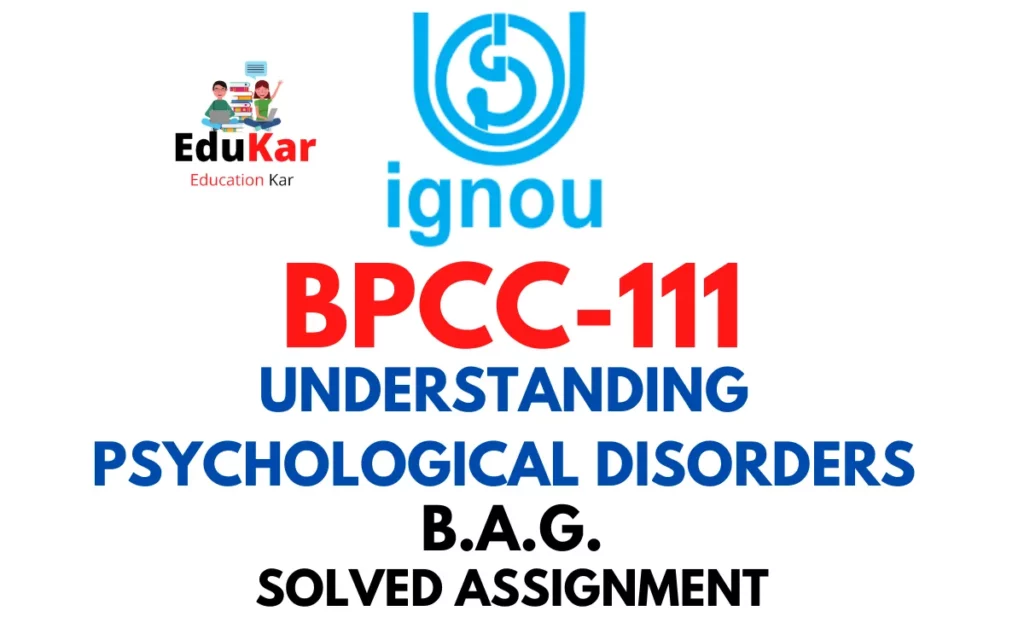
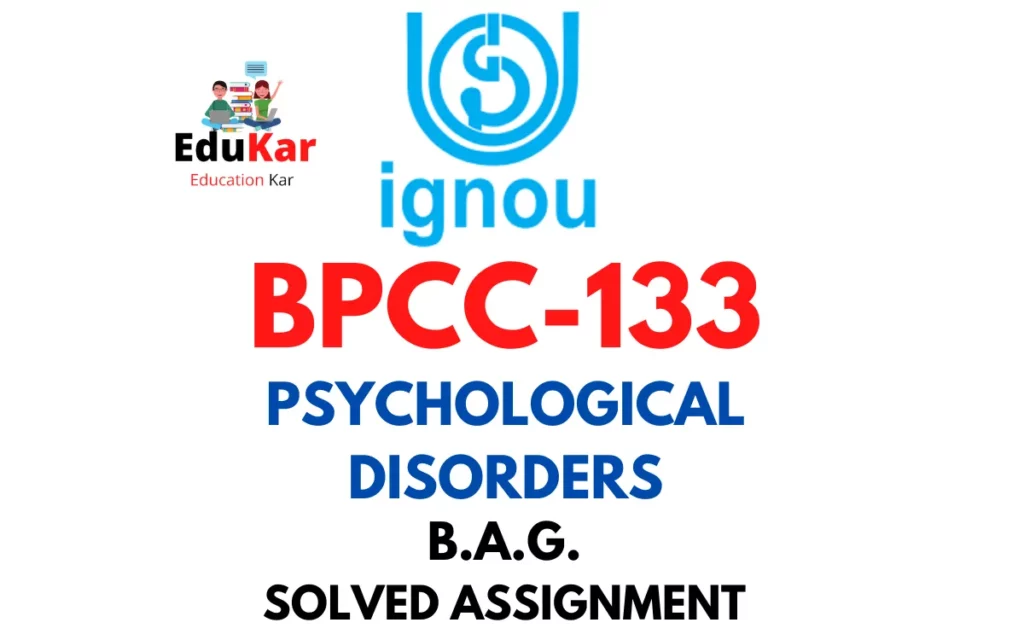
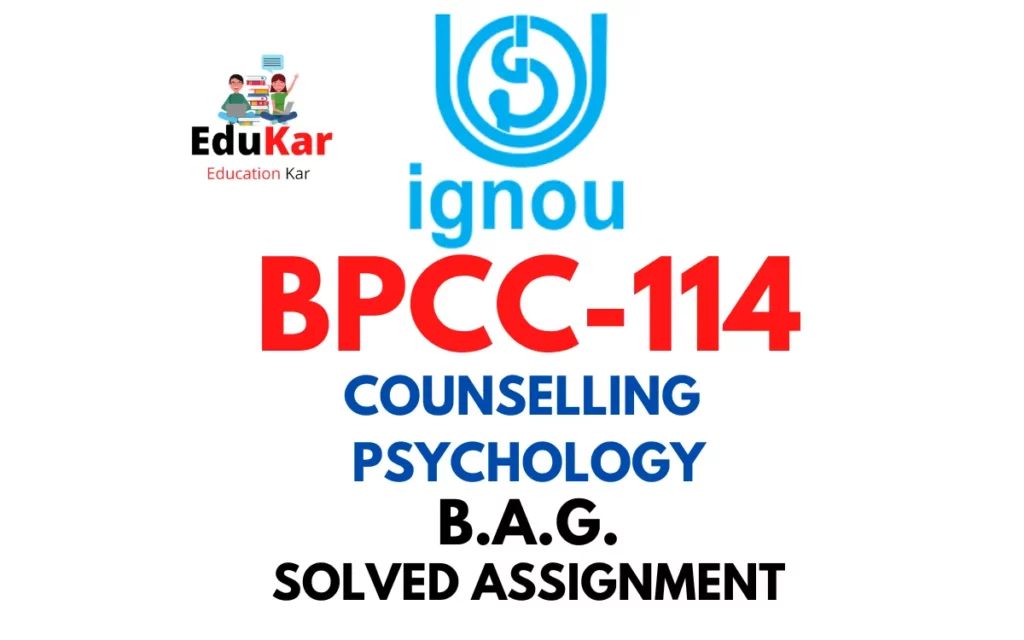
![[Solved Assignment] BPCS 188-APPLICATIONS OF SOCIAL PSYCHOLOGY (IGNOU-BAG) 2022-2023 BPCS 188-APPLICATIONS OF SOCIAL PSYCHOLOGY IGNOU BAG Solved Assignment 2022-2023](https://edukar.org/wp-content/uploads/2023/01/BPCS-188-APPLICATIONS-OF-SOCIAL-PSYCHOLOGY-IGNOU-BAG-Solved-Assignment-2022-2023-1024x640.webp)
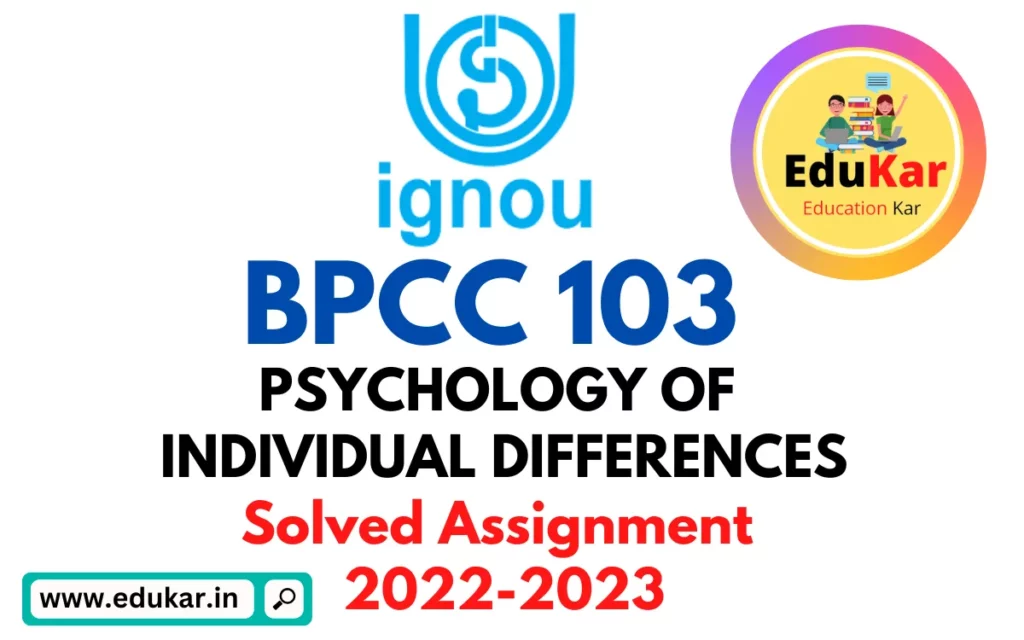

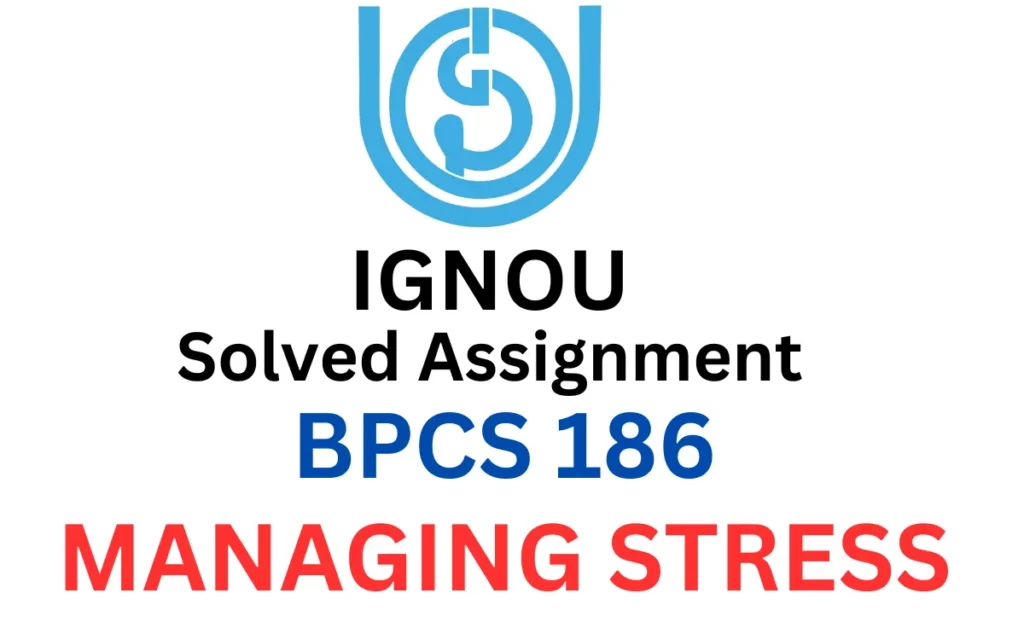
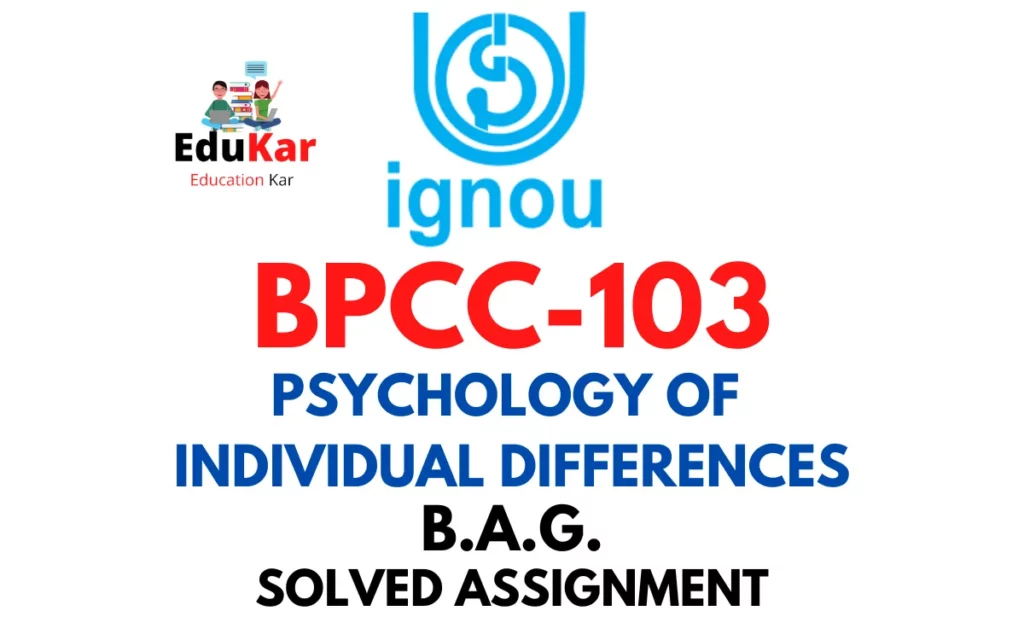

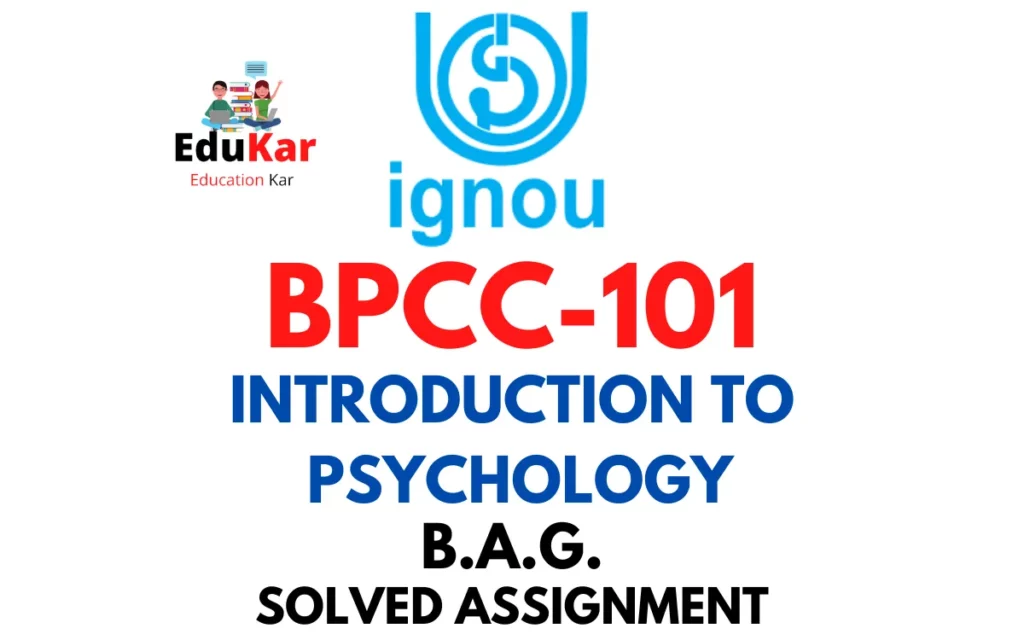
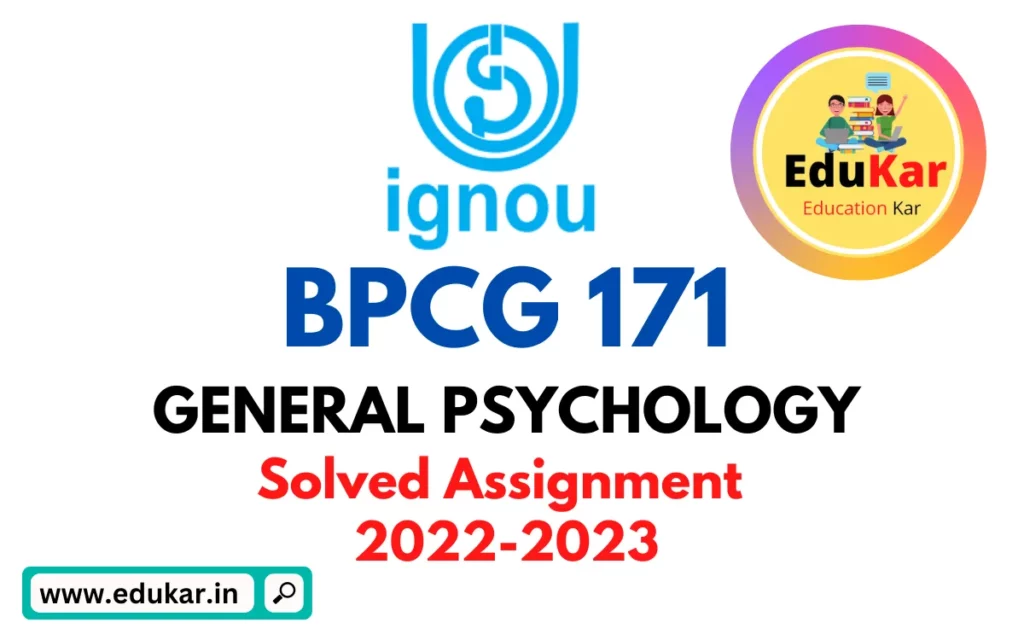
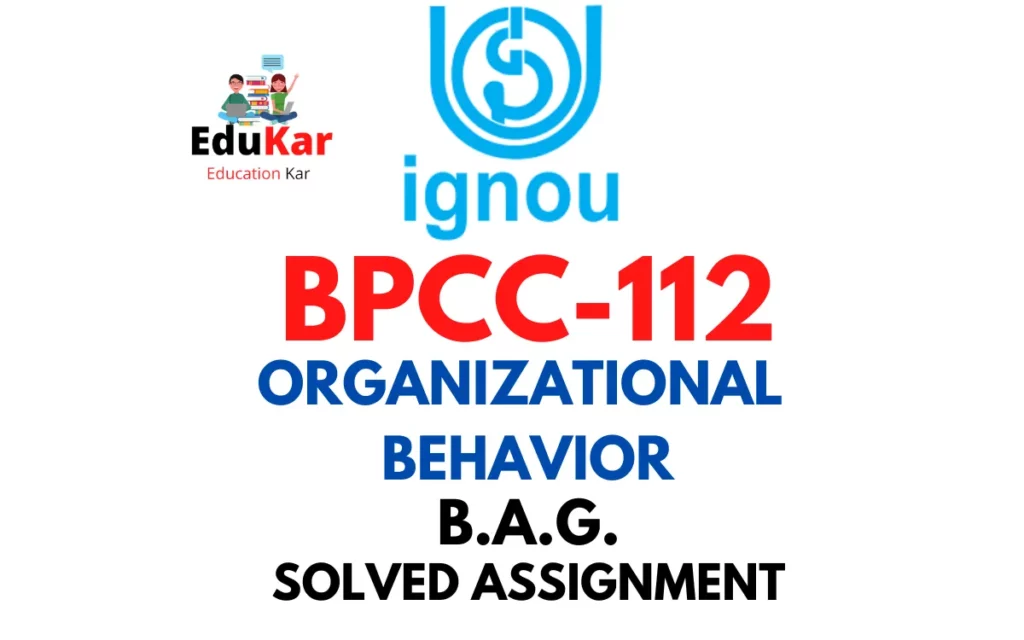
![[Solved Assignment] BPCS 185-DEVELOPING EMOTIONAL COMPETENCE (IGNOU-BAG) 2022-2023 [Solved Assignment] BPCS 185-DEVELOPING EMOTIONAL COMPETENCE (IGNOU-BAG) 2022-2023](https://edukar.org/wp-content/plugins/contextual-related-posts/default.png)

